How to detect and treat apple tree diseases in time
Diseases of apple trees are numerous and varied. Conventionally, they can be divided into diseases of trees (bark, trunks) and diseases of fruits. Tree disease often affects the fruit, and fruit diseases develop during flowering or even budding. The last stage of the pathological process is usually visible on apples.This article provides detailed descriptions of the main diseases of apple trees with photographs, signs of the disease, effective methods of treatment and prevention.
| Content:
|
|
If a gardener can protect apple trees from diseases and pests, then the trees will thank him with an excellent harvest |
How to deal with apple tree diseases
Black cancer
Fungal disease of apple tree. The pathogen persists under the bark, on plant debris, fallen fruits, and stumps for 5-6 years. A tree becomes infected through wounds: large cuts, frost holes, sunburn. Old weakened trees are more often infected. Now in the middle zone the disease has spread widely, although before it was not so widespread. It affects apple and pear trees, but apple trees suffer from it much more often.
Signs of damage to an apple tree by black cancer
The disease manifests itself on the bark (especially in the forks), leaves, flowers, and very rarely on fruits.
|
Black cancer - a disease of the trunk and bark of an apple tree |
The disease develops gradually and until there is a serious lesion, it practically does not manifest itself. The first signs of the disease appear on the bark in the forks of skeletal branches or on the trunk. On bark small brown spots appear, which gradually darken. As a rule, during this period the summer resident does not pay attention to these symptoms. Later, the bark turns black, becomes covered with small cracks and looks like a charred firebrand. It begins to crumble and peels off from the wood in entire layers. Bare wood quickly darkens.
|
This is how the disease develops on the branches of an apple tree |
On leaves dark brown blurry spots appear, in the center of which black dots gradually appear. If leaves are severely damaged, they fall off 1.5-2 months before leaf fall begins.
Affected flowers They shrivel, their stamens and pistil are black, and they usually do not pollinate.
Fruit are affected 2-3 weeks before the onset of technical maturity. They turn black and mummify, but there is no blue tint (as with moniliosis). As a rule, individual apples are affected. There is no mass damage to fruits with black cancer.
Forecast. If the trunk is damaged, the tree dies within 1-2 years. If the skeletal branches are affected, then with proper care you can get rid of the disease. But on old trees, even with the best care, the cancer spreads throughout the crown and the tree dies. Young trees, if timely measures are taken, are cured of the disease within 2-3 years.
Terms of distribution. Cancer spreads more rapidly in damp, cool weather. Infection occurs in April-May. With compact planting (the distance between apple trees is less than 4 m), the trees are affected within 1-2 years. Here the symptoms look different: the bark darkens, but does not char, but becomes covered with a network of cracks and crumbles.
|
This is what black cancer looks like on the leaves, branches and fruits of an apple tree |
Measures to combat the disease
The sooner they are taken, the greater the chance of saving the tree.
- Treatment of the soil, trunk and crown with iron sulfate. The sore spot is cleaned with a knife, removing the diseased bark and the top layer of adjacent wood. Spray with a 2% solution of the drug (200 g of iron sulfate per 10 liters of water). They treat not only the sore spot, but also the entire crown, as well as neighboring apple and pear trees. After the solution has dried, the cleaned area is painted over with natural drying oil paint.The paint prevents air access and causes the death of the pathogen. A 3% solution of the drug is poured over the tree trunk. Treatment is carried out 2 times a year - late in the fall and early in the spring after the snow melts, but before the buds begin to swell.
- Spraying the trunk and skeletal branches with copper-containing preparations (CHOM, OxyCHOM, Bordeaux mixture, etc.). It is rather preventive in nature and is carried out to prevent further spread of the disease from the lesion. Treatment is carried out in mid-to-late June in the evening in dry weather. The trunk and crown, as well as neighboring trees, are sprayed for prevention.
- Pruning drying branches. If possible, they are cut out even in the summer, since they are the main breeding ground for infection.
When stripping a tree, all bark must be collected and burned. If left under the apple tree, it will become an additional source of infection in the garden.
Disease prevention
In a garden where it is carried out regularly, black cancer is unlikely to appear.
- Regular preventative spraying of the garden against diseases and pests. Prevention is carried out in spring and autumn by spraying plantings with copper-containing preparations.
- Regular pruning of apple trees. Cancer spreads quickly in dense crowns.
- Thorough cleaning of plant residues.
- Good feeding and care increase the resistance of apple trees to diseases, and sick ones, with proper care, shed the disease (if they are not too old).
- Treatment of wounds, cracks, burns, caulking of hollows.
- If the spread is strong, varieties that are resistant to the disease are selected (Golden Delicious, Discovery, Idared are relatively resistant).
If the bark begins to peel off, the diseased branch is immediately cut out. If the bark peels off on the trunk, the apple tree is cut down; it cannot be cured.At the same time, the wood of such trees is very good, without signs of damage, it cannot be said from it that the tree was affected by cancer.
For 2 years, you cannot plant apple trees within a radius of 2 m from a tree that was sick but cured, and for 5 years where the apple tree died.
After cutting out the diseased tree, the ground and stump are watered with a 5% solution of iron sulfate.
Scab
A widespread fungal disease of apple trees. Affects fruit trees, citrus fruits, potatoes, etc. But each culture has its own specific pathogen. Scab of apple and pear trees affects only them and does not spread to other plants in the country.
Causes of occurrence. There is no consensus among scientists about the causes of the disease. The main reason is considered to be high soil moisture and very damp, cold summers with temperatures of 18-22°C. However, scab appears both in wet years and in dry years, although somewhat less. Most of the most famous and best varieties are affected by scab. The varieties Melba, Antey, Lithuanian Pepin, etc. are very unstable to the disease.
Signs of apple scab disease
The most common apple tree disease. It affects buds, leaves, flowers, fruits and young shoots. The easiest way to observe manifestations is on the leaves. Dark green spots appear on them, which then turn brown. The size of the spots depends on the time of onset of the disease. During spring infection, the spots are large with somewhat blurry edges. During summer infection, the spots are small and inconspicuous.
|
The disease is clearly visible on the leaves and fruits of the apple tree. |
When flowers are damaged, small brown spots appear on them. Spots of varying sizes also appear on the ovaries and buds. The ovaries do not develop and fall off.If the disease spreads strongly at this time, you may be left without a crop. In very susceptible varieties, shoots are affected. Sagging appears on them, which later ruptures, forming cracks.
Olive spots appear on the fruits, which eventually cork and crack. With early scab infection, the apple grows poorly and becomes deformed. With late infection, brown-black spots appear on apples, which become cork during storage.
Sometimes you can find corked areas on purchased apples. This is scab. With minor damage, the apple is suitable for consumption, although its presentation is reduced. If the damage is severe, apples are unsuitable for consumption.
Methods for treating scab on apple trees
Fighting scab is extremely difficult. Varieties that are resistant to the disease in some regions may be susceptible to it in others because the strain is different there. The pathogen very quickly develops resistance to drugs. Therefore, trees are sprayed with different chemicals throughout the season. In case of severe damage, 4-5 treatments are applied during the growing season. If it is weak, 2-3 treatments are carried out.
- Early spring until swelling (do not bloom!) The buds are sprayed with a 2% solution of ferrous sulfate.
- Spraying with Rayok during blossoming buds or buds. But only either/or. If apple trees were treated with the drug before flowering, then it can no longer be used during bud break. Two treatments in a row with the same drug lead to resistance of the pathogen to it. Rayok can be replaced with Skor. It contains the same active ingredient.
- During the growing season, spray with Strobi, Polyram or copper preparations.However, copper is more suitable for prevention or for small focal development of the disease.
- For minor damage, biological products are used: Fitosporin, Baktofit, Gamair. they all contain the same bacterium, but different strains. Therefore, if the disease does not spread, you can alternate these drugs. Treatment with biological products is repeated after 10 days in damp, cool weather, and after 14 days in dry weather.
Folk remedies with minor damage they are very effective. Apple trees are treated with a light crimson solution of potassium permanganate. If the disease does not progress, then potassium permanganate is alternated with biological products. As the disease develops, they switch to chemical remedies.
|
Scab is extremely common in industrial plantings, where it is very harmful. In summer cottages it is not so dangerous and mainly affects fruits, although outbreaks of the disease occur from time to time. |
Disease prevention
Helps control the disease, although it does not reduce the damage.
- Growing resistant varieties. Chulanovka, Liberty, and Belorussky Sinap are relatively resistant to scab. Antonovka is also quite stable. It has been growing in my dacha for about 40 years. I don’t know how it used to be, but over the past 30 years, scab has occurred on it infrequently, once every 3-5 years. Mostly leaves were affected, but not on all trees (I have 3 of them), but on one, different each time. Fruits were affected extremely rarely, and only in single specimens. Although other, more susceptible varieties get sick every year.
- Cleaning up plant debris under affected trees.
- Timely pruning of weak and diseased branches.
- Crown thinning. Scab spreads greatly in thickened crowns.
When planting apple and pear trees, you need to maintain a distance of at least 4 m between trees. If this is not possible in a small area, then plant scab-resistant varieties between severely affected varieties.
Common or European cancer
A widespread fungal disease of apple trees. It affects fruit and berry and ornamental deciduous trees. Preserves on damaged wood and plant debris. Fungal spores penetrate inside through damage to the bark: frost holes, sunburn, large untreated saw cuts.
Signs of the disease
Signs of the disease initially appear on the bark of the apple tree, later on the leaves and fruits. Brown oblong spots appear on the bark, which later crack. Ulcers with raised edges form underneath them. Ulcers are of open and closed type. Open ulcers often form on the trunk; they look like frost holes, only at the edges they have a ridge of callus deposits, and they form during the growing season, and not in winter. Closed-type ulcers form on skeletal branches - the callus edges of the ulcer grow together, leaving a small gap. Whitish pads appear in the ulcer, darkening over time - fungal sporulation.
|
The disease first affects the bark of apple trees. |
The leaves on a diseased apple tree become light green in color and large brown spots appear on them, most of which are located along the edge of the leaf. Leaf disease resembles potassium deficiency, but cracks in the bark indicate a fungal disease. Leaves dry out and fall off prematurely. Brown spots appear on apples near the stalk, which grow and cause them to rot.
Young trees die within 1-2 years. It is quite difficult to cure mature fruit-bearing apple trees, but it is still possible.
Methods for treating apple trees against European cancer
Disease control measures include agrotechnical and chemical measures.
Agrotechnical
- Cutting out diseased branches and subsequent treatment with fungicides. Pruning is carried out not directly under the lesion, but 20-30 cm before it, since the mycelium has already spread further, but there are no visible signs of damage yet.
- Cutting out diseased areas to healthy wood and obligatory burning of the affected remains.
- When pruning a diseased tree, all cuts are covered with garden varnish.
Agrotechnical measures must be carried out with subsequent chemical treatment.
Chemical treatments
- In early spring and late autumn, the trunk and crown are sprayed with a 2% solution of iron sulfate. Ulcers are treated most thoroughly.
- During the growing season, ulcers are sprayed every 10 days with a solution of copper-containing preparations (HOM, Abiga-Peak, etc.) throughout the entire growing season.
|
Apple trees that are severely affected by the disease are uprooted, since they can no longer be cured, and they themselves are a breeding ground for the disease. |
Disease prevention
Prevention is very effective. The disease will not appear where preventive measures are carried out at the proper level.
- Processing of all planting material, because most often the disease enters the dacha from the nursery. To prevent all types of cancer, before planting, seedlings are soaked in OxyHOM solution (with an open root system) or watered with the same solution (if the root system is closed). The above-ground part is sprayed with a solution of the drug.
- All cuts and cuts are carefully covered with garden varnish. Large saw cuts are painted with oil paint on natural drying oil.
- Clean and cover hollows, frost holes, and sunburn.
- When the first signs of disease appear, the branches are immediately cut out.
- High agricultural technology for apple trees: regular fertilizing, watering, proper pruning, etc.
- Cultivation of resistant varieties: Antonovka, Golden Delicious, Idared, Lobo, Fantasia, Cortland, Oryol Polesye, Amulet, Zolotoe Letnee, Rodnichok, Prima, Bolotovskoye.
Basically, bark diseases are brought to the site from the nursery.
With dense plantings, the disease spreads quite quickly. If any bark cancer appears in the garden, then it is advisable to remove all decorative deciduous trees growing between the apple trees, since they are also actively affected by the disease and become transmitters of the disease from one apple tree to another.
Tubercular disease or drying out of branches
The causative agent is a pathogenic fungus. It affects not only apple trees, but many trees and shrubs, including viburnum, rowan, lilac, and various types of maples. But the main carrier and distributor of the pathogen is red currant, for which tuberculosis is the main disease. Preserved on damaged bark.
Signs of apple tree tubercular disease
The disease affects the bark of the apple tree, leaves and shoots, especially young ones. Small red pads appear on the bark, which darken and dry out over time. The mycelium grows into the phloem, causing individual shoots to dry out. The development of young shoots slows down greatly, and they can also dry out. The leaves on the affected shoot lose turgor and dry out.
|
The disease is clearly visible on the bark of apple trees. |
Treatment options
Measures to combat the disease should start with red currants. When affected branches appear, they are cut out, even if they have clusters of berries. The branch will still not produce a harvest and will dry out.
- If possible, cut out all diseased branches on the apple tree.
- If skeletal branches or trunks are affected, spray with Topsin M.
- The drug Captan. It is used for scab, but even in this case it is effective. It has a short duration of action of 5-7 days, so it is either combined with other drugs or several treatments are carried out with an interval of 5 days.
- Treatment with copper preparations.
At my dacha, a red currant fell ill, and the disease quickly spread to a neighboring apple tree. Treatment first with Topsin M, and then spraying 3 times with HOM helped completely get rid of the disease on the apple tree and almost completely on the currants. Some branches still had to be cut.
Disease prevention
Twice spring spraying with copper preparations helps a lot. The first time the treatment is done immediately after the snow melts, the second time after flowering. Red currants are sprayed especially carefully.
Folk remedies. Treatment with potassium permanganate helps a lot. When the snow melts, for preventive purposes, the trunk and branches of apple trees are sprayed with a dark crimson solution. After the leaves bloom, another treatment is done, spraying the bark on the trunk and skeletal branches. And, of course, they process red currants.
Powdery mildew
Fungal disease of apple trees. The parasite “specializes” in apple trees, but can also infect pears. It overwinters on plant debris, in fallen leaves and the bark of affected shoots; the mycelium of the fungus overwinters in the buds of the shoots, from which the disease begins in the spring. Affects leaves, buds, flowers and shoots.
The disease is widespread in the southern regions: the North Caucasus, Crimea, Krasnodar Territory, as well as in Ukraine and Belarus. In the northern regions, the disease occurs in patches during hot and humid summers.
Signs of apple tree disease with powdery mildew
The disease appears on the apple tree in the spring when leaves and buds bloom. Grayish-white spots appear on young leaves. Later they turn brown, the leaves curl and dry out. As the leaves bloom, the focus of the disease grows. Plaque intensively covers young leaves. When infected in summer, the disease is less destructive. The spots appear locally on individual leaves; as a result, they curl into a tube along the central vein and slowly dry out.
|
Powdery mildew on apple trees can be identified by a white coating on the leaves |
In summer, white spots also appear on growing shoots. The shoots stop growing and become deformed.
The affected buds do not develop and fall off. If the infection occurs later, then a rusty mesh of corked peel appears on the ripening apples.
Measures to combat the disease
Powdery mildew especially affects young apple trees and apple trees with a thick crown. It is rampant in nurseries, so purchased planting material must be carefully checked.
Chemicals
- Tercel. The drug works well in the spring, showing activity at temperatures from 15°C, which compares favorably with other pesticides, the activity of which appears only from 20°C. Treatments are carried out in the spring during the period of budding and flowering.
- Rayok. Well protects apple trees during the growing season. Trees can be treated after flowering has ended and then throughout the entire growing season. Rayok can be replaced by Skor or Guardian. These drugs have one active ingredient.
- They use the drugs Strobi and Topaz.
Powdery mildew quickly becomes resistant to chemicals, so do not treat with one drug more than 2 times in a row. In the fall, with the beginning of leaf fall, apple trees are again sprayed with Tarcel.Winter varieties are processed immediately after apples are picked.
For small spread of the disease, use biological products: Fitosporin, Sporobacterin, Baktofit.
Folk remedies used for small foci of disease spread. Treatment in early spring with a strong raspberry solution of potassium permanganate helps a lot. If the buds are already opening, then use a slightly pink solution.
Prevention of powdery mildew on apple trees
It helps well with local spread of the disease. With mass distribution, it is not so effective.
- Preventive “blue” spraying of the garden with copper-containing preparations in early spring.
- Collection and destruction of plant residues.
- Crown thinning.
- Removing young shoots damaged by powdery mildew.
- Limit the use of nitrogen fertilizers. A tree overfed with nitrogen is more easily affected by the pathogen.
- Cultivation of resistant varieties: Jonagold, Carmen, Granny Smith, Zephyr, Amulet, Gloucester, Fairy, Argo, Red Poppy, Rodnichok, Duet.
All varieties must be zoned to local climatic conditions.
Cytosporosis
The causative agent is a pathogenic fungus. There are 2 types of pathogens, one parasitizes only the apple tree, the second can infect both apple and pear trees. The infection persists on the bark and affected branches. Very common in nurseries. Occurs on apple trees with damaged bark: frost damage, sunburn.
Signs of apple tree disease with cytosporosis
The pathogen parasitizes the bark of a tree, causing the death of individual areas. Many gray-brown protuberances appear on the bark of the trunk and skeletal branches. The tubercles gradually break through, the bark takes on a finely tuberculated appearance and begins to peel off, but does not peel off.The fungus penetrates the cambium and wood, which disrupts sap flow. Sick branches dry out. When the trunk is damaged, the tree dies.
The infection spreads greatly in the thickened crown. The disease affects young, fruit-bearing and old trees.
|
This is what cytosporosis looks like on apple bark |
Treatment of the disease
The damaged area is cleaned of soaked wood. Remove it to healthy green tissue. All diseased bark is carefully collected and burned.
- Since the gardener discovers the fungus already in the summer, the cleaned area is treated with Horus and covered with oil paint on natural drying oil.
- In the fall, after leaf fall, the damaged areas are treated with iron sulfate.
- Cutting out diseased branches.
If the hearth rings the entire trunk, the tree will die.
If there is even a small area of healthy bark, then all shoots coming from below are left. The following year they are used for bridge grafting.
Prevention does not prevent cytosporosis, but reduces the risk of its occurrence.
- Thinning thickened crowns.
- Autumn whitewashing of trees to prevent damage to the bark in winter.
- Complete removal of plant residues.
Cytosporosis is a very dangerous disease. If the tree is dead, the area is sprinkled with bleach. For 5 years, apple trees, pears, apricots, and peaches cannot be planted here.
Don't forget to read:
Moniliosis
The causative agent is a pathogenic fungus. Strictly speaking, there are two pathogens here, which are closely related pathogens: the first causes a burn in early spring, the second affects the fruits, leading to their rotting. However, there is an opinion that the disease is caused by the same fungus, but at different stages of development.The parasite persists on plant debris, as well as rotten fruits hanging on the apple tree.
Signs of apple tree disease with moniliosis
The first stage of the disease appears in early spring during bud break and flowering. A red spot appears on young leaves and the central vein is affected. Along it, the mycelium reaches the base of the rosette of leaves. They turn brown, droop, but do not fall off. Flowers, ovaries and young fruit branches are also affected. They dry out, but also remain on the apple tree. This is called a monilial burn.
|
Moniliosis first appears on the leaves of the apple tree, and then spreads to the fruits |
Fruit rot attacks fruits in summer. The pathogen is introduced where there is a hole gnawed by the codling moth. A characteristic red-brown spot appears, which eventually spreads to the entire fruit. After a while, gray sporulation pads appear on the rotted surface. The infected fruit dries out, mummifies, acquires a blue-violet tint and turns black. Such fruits can hang on the tree all winter. The disease also spreads when apples are stored. These fruits are a constant source of infection. Spores are spread by wind, insects, and rain.
Methods for treating moniliosis
Control measures begin when the buds open.
- Early “blue” spraying of the garden with copper preparations (HOM, Abiga-Peak, etc.).
- Treatment with Strobi. Before and after its use, other drugs are used.
- Tercel. The drug is effective over a wide temperature range. Can be used in both cool weather and extreme heat.
- Horus. Treatment is carried out when the leaves bloom or after flowering ends.
- When the disease spreads slightly, biological products are used: Fitosporin, Gamair, Sporobacterin.
Fruit rot behaves differently in different years. Sometimes it doesn’t exist at all, sometimes it rages on apple trees.
To control moniliosis, you need to spray the entire apple tree - from the top to the trunk circle. It is impossible to do this on tall varieties in the conditions of a summer cottage. Therefore, in dachas the disease is always present, but it can be controlled.
Folk remedies. In the spring, when the buds swell, the trees are treated with a urea solution. 600 g per 10 liters of water.
When filling apples, trees are treated with iodine solution: 5 ml per 10 liters of water. Processing is carried out when the apples reach the size of a walnut. It can also be done for preventive purposes.
|
If the infection is not dealt with, then in a few years all the trees will be affected, and it will become extremely difficult to cope with the disease. |
Disease prevention
It is required. It significantly reduces the spread of the disease.
- Removal and destruction of rotten fruits. You cannot throw them into a compost pit, this only increases the spread of moniliosis.
- Cleaning up plant residues.
- Removing dry and diseased branches. If there are signs of damage on a branch, then it is cut out even in summer, retreating another 7-10 cm from the site of the defeat.
- Crown thinning.
Do not miss:
How to properly care for young apple trees in spring, summer and autumn ⇒
How to care for fruit-bearing apple trees throughout the year ⇒
Mosses and lichens on an apple tree
Reasons for appearance. Mosses and lichens are found on all fruit and berry crops. They occur where there is poor lighting, stagnant air, high humidity and a thick crown. Even if it seems to the summer resident that the apple tree is in ideal conditions, and mosses have appeared on the trunk and branches, then there are favorable conditions for this.In poor conditions, mosses and lichens will not appear.
Is it necessary to fight them? It is believed that there is no need to fight lichens and mosses. They live on the bark, do not destroy wood and do not feed on tree sap. But they always contain moisture, which is a favorable environment for the development of pathogens, especially fungi that cause damage to the bark. In addition, many pests hibernate under them. Therefore, it is necessary to clear trees of them.
|
If mosses and lichens appear on apple trees, then the trunks must be cleaned and treated with iron sulfate |
Cleaning wood. Clean tree trunks in cool, damp weather so that the moss and lichen swell, then they are easier to remove. If the weather is dry, then work is carried out in the morning on dew. The branches are cleaned with a hard mitten, the back (not sharp) side of a knife, a spatula, or an iron brush.
The bark should remain intact. Mosses and lichens can be removed very easily; there is no need to clean the wood so that splinters fly from it. Even old, cracked bark is cleaned very carefully.
Prevention
Mosses and lichens appear where the crown is thick and poorly blown by the wind. Therefore, the crown is thinned out. They often appear in dachas that are located next to the forest.
If there is no forest near the dacha, the crown is well sparse, and lichens and mosses appear again and again and quickly spread even to young trees, then you should check the acidity of the soil. They stubbornly appear on trees growing in acidic soils. The soil is deoxidized by adding dolomite flour. You can add ash if there is enough of it. Particular attention should be paid to the beds located along the perimeter of the crown and deoxidize the soil there.Since apple trees receive a fairly large amount of nutrients from regional nutrition.
|
After stripping the crown in late autumn or early spring, the trees are treated with a 2% solution of ferrous sulfate. If there is still something left on the apple trees, it will fall off on its own after such treatment. |
When there is a strong spread of lichens and mosses, apple trees are whitened to the maximum possible height. After whitewashing, tree bark remains clean for a long time.
Conclusion
The apple tree lives in the country for decades. And during this time she will have to be treated more than once. Almost all apple tree diseases can sooner or later lead to its death. Therefore, as soon as the first signs of the disease are detected, the necessary measures must be taken immediately. The earlier the treatment of the apple tree is started, the less damage to the tree, to the crop and to the summer resident.
Similar articles:
- Treating the garden in spring against diseases and pests ⇒
- Gooseberry diseases: description of diseases, photos and methods of treatment ⇒
- Diseases of black and red currants: description, photos and methods of treatment ⇒
- Main strawberry diseases and methods of their treatment ⇒
- Treatment of raspberries for diseases, description, photos of diseased bushes and methods of treatment ⇒
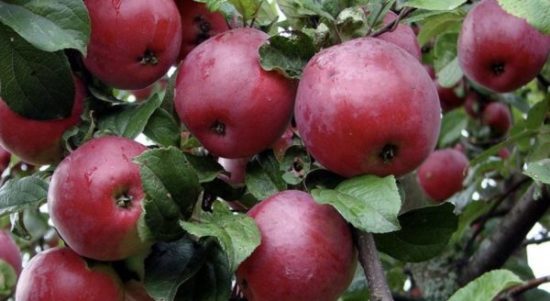

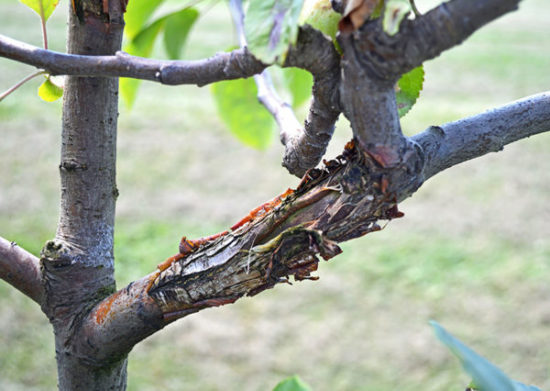
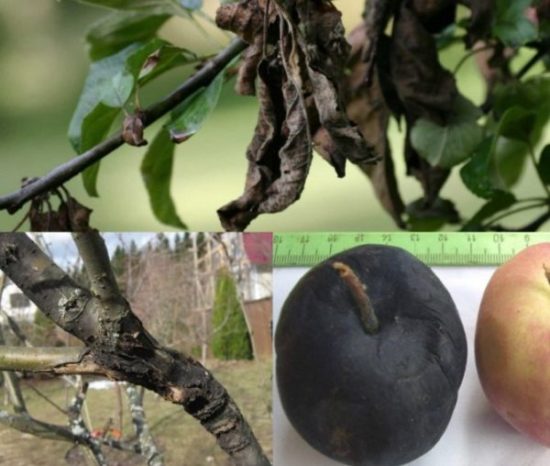
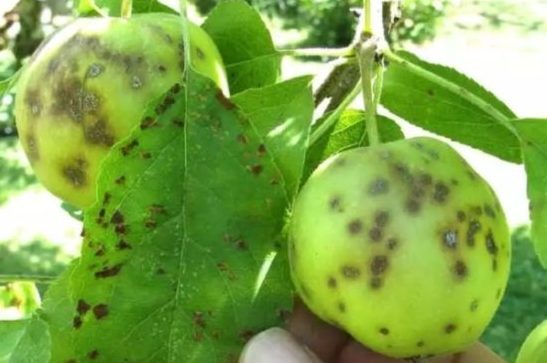
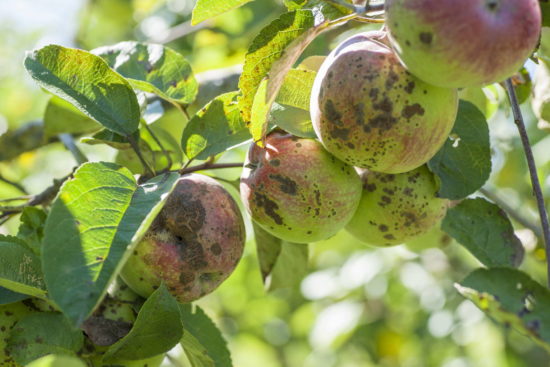
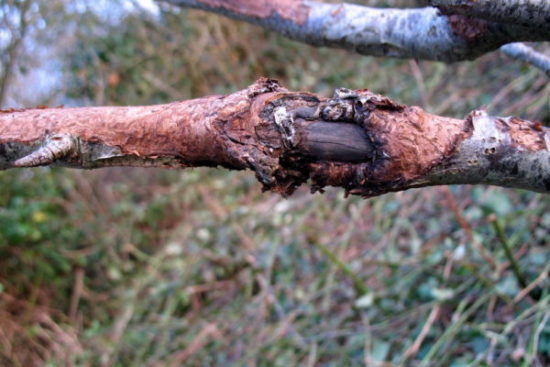
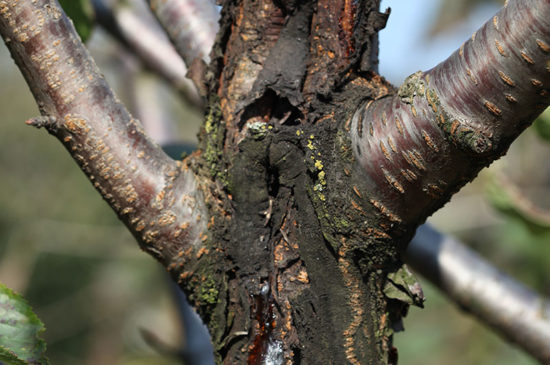
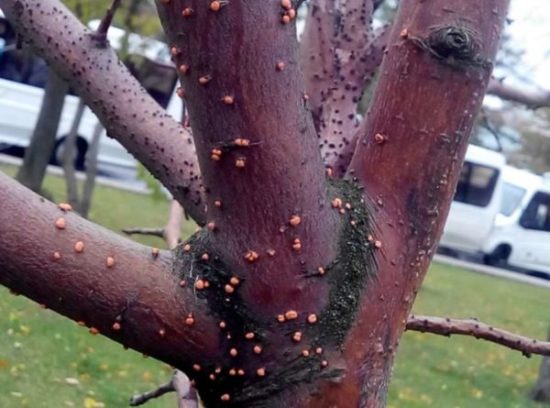
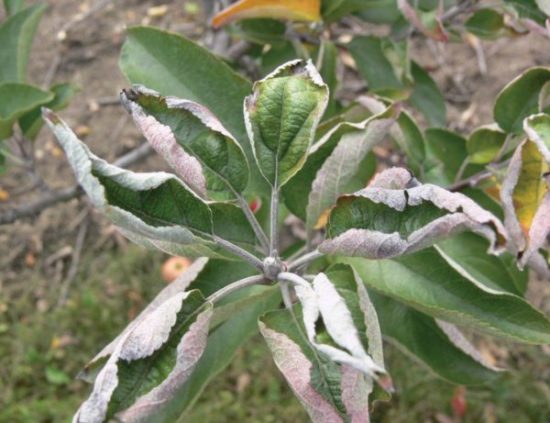
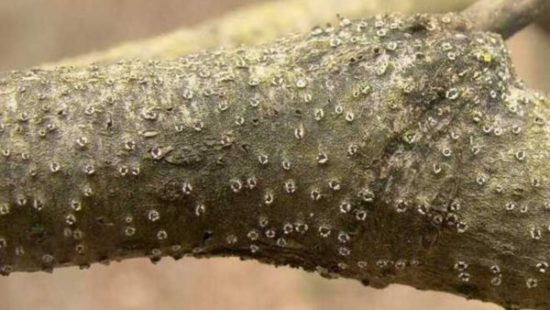
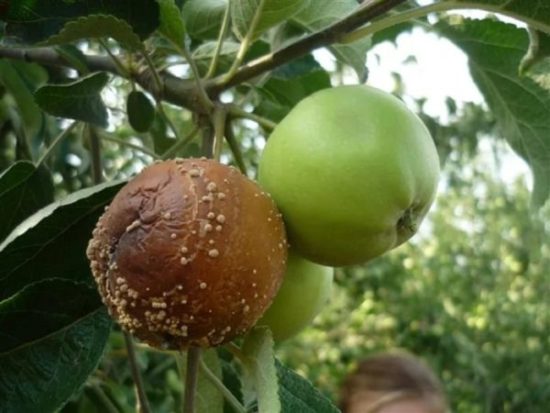
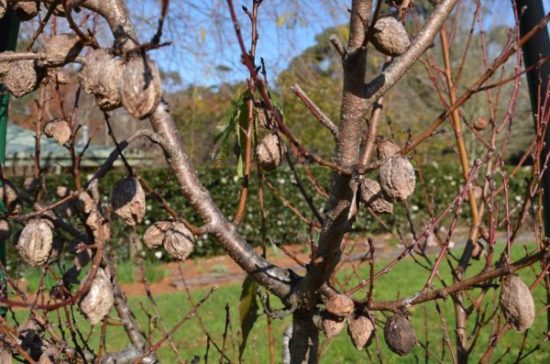

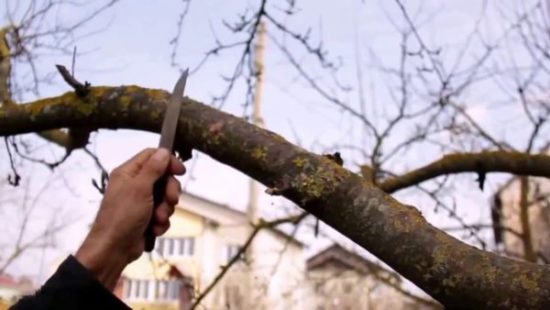

 (11 ratings, average: 4,27 out of 5)
(11 ratings, average: 4,27 out of 5) CUCUMBERS NEVER GET SICK, I'VE BEEN USING ONLY THIS FOR 40 YEARS! I SHARE A SECRET WITH YOU, CUCUMBERS ARE LIKE THE PICTURE!
CUCUMBERS NEVER GET SICK, I'VE BEEN USING ONLY THIS FOR 40 YEARS! I SHARE A SECRET WITH YOU, CUCUMBERS ARE LIKE THE PICTURE! You can dig a bucket of potatoes from each bush. Do you think these are fairy tales? Watch the video
You can dig a bucket of potatoes from each bush. Do you think these are fairy tales? Watch the video
 How our fellow gardeners work in Korea. There is a lot to learn and just fun to watch.
How our fellow gardeners work in Korea. There is a lot to learn and just fun to watch. Eye trainer. The author claims that with daily viewing, vision is restored. They don't charge money for views.
Eye trainer. The author claims that with daily viewing, vision is restored. They don't charge money for views. A 3-ingredient cake recipe in 30 minutes is better than Napoleon. Simple and very tasty.
A 3-ingredient cake recipe in 30 minutes is better than Napoleon. Simple and very tasty. Therapeutic exercises for cervical osteochondrosis. A complete set of exercises.
Therapeutic exercises for cervical osteochondrosis. A complete set of exercises. Which indoor plants match your zodiac sign?
Which indoor plants match your zodiac sign? What about them? Excursion to German dachas.
What about them? Excursion to German dachas.